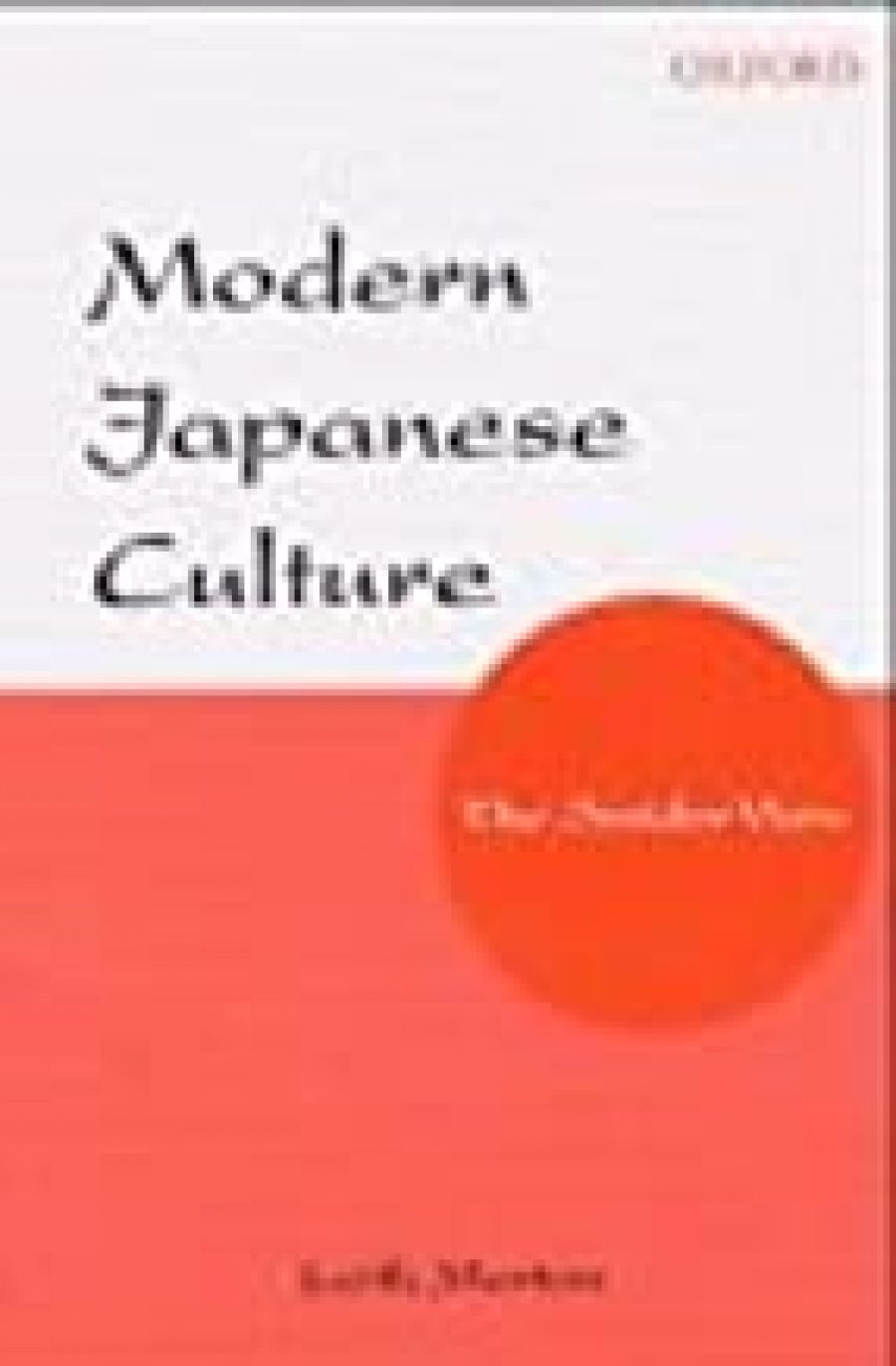
- Free Article: No
- Contents Category: Japan
- Review Article: Yes
- Article Title: Sushi without rice
- Online Only: No
- Custom Highlight Text:
Modern Japanese Culture – what a seductive title! It evokes images of a fast-paced, technologically advanced nation with deep traditions reinventing itself as a post-industrial society with a rich culture. We immediately think of Kurosawa’s epic films, manga comics and anime, contemporary ceramics, video games, Issey Miyake’s extravaganzas, the sublime minimalism of Ando Tadao’s architecture, and the photography of Ishida Kiichiro, currently on display at the Museum of Sydney.
- Book 1 Title: Modern Japanese Culture
- Book 1 Subtitle: The insider view
- Book 1 Biblio: OUP, $49.95 pb, 295 pp
Leith Morton’s latest book is an engaging study of Japanese literature, cinema, television, and manga of the second half of the twentieth century. It makes an original contribution to the study of these fields by analysing the role of noted Japanese intellectuals and ‘thinkers’ in shaping the perception of contemporary Japanese culture. This is the ‘insider view’ of the book’s subtitle. Morton argues for the importance of ‘insider discourse’ for countering externally conceived analyses of Japanese culture by presenting the preoccupations of influential Japanese writing in the Japanese language, for a Japanese audience. He states that the role of Yanagita Kunio was seminal in shaping ‘an indigenous system of nativist ethnology’, which in turn had ‘an enormous impact on the postwar obsession with the quest of national identity’ in Japan. These issues are explored authoritatively in Chapter Two, using a wealth of material in Japanese, which has not appeared in English before. Chapter Three analyses the work of the champion of the New Left in the 1960s, Yoshimoto Takaaki, who, Morton notes, ‘introduced television and manga as topics of serious intellectual discourse’.
Morton’s book is based on substantial scholarship and facility in the Japanese language. It will be valuable as assigned reading for courses in Japanese literature, anthropology, and cultural studies, as well as for a wider audience wanting to learn more about how Japanese critics and commentators defined Japanese culture in the twentieth century.
The title of the book may be all-encompassing. Unfortunately, it also creates unreasonable expectations about its scope and focus. I suspect the publisher, more than the author, may be responsible, but this does both the author and the potential audience a disservice. This is a well-crafted study of influences on perceptions of Japanese literature, culture, cinema, manga, and television. It is not a study of ‘modern Japanese culture’ in its multiple forms and permutations. It is not appropriate to have a book entitled Modern Japanese Culture with no reference to music or architecture: no New Age music; no memorial to wartime tragedies; no eternal homage to ephemeral youth (and pink spiked hair) or to the urban subculture of the Harajuku district of Tokyo; no reference to the irrepressible regeneration of Tokyo’s Roppongi, with high-rise edifices as temples to consumerism, or to the Tokyo 1964 Olympic buildings of Tange Kenzo, which defined Japan’s recovery from war and marked Japan’s readmission to the international community. These icons of modern Japanese culture have each stimulated copious ‘insider’ responses.
The pretensions of the book title carry over to the title of Chapter Four, ‘The Literature of Contemporary Japan’. At the beginning, we learn that we can expect ‘a snapshot of modern Japanese literature by examining some of the most important creations of a few of the most significant authors of postwar and contemporary Japan’ (my emphasis). We are then referred, appropriately, to Donald Keene’s Dawn to the West (1984) for a comprehensive coverage of this topic. This book is disappointingly omitted from Morton’s otherwise exhaustive list of references. Fortuitously, the snapshot captures the towering figures of Mishima Yukio and the second Japanese winner of the Nobel Prize for literature, Oe Kenzaburo. However, Kawabata Yasunari, the first Japanese to be awarded the Nobel Prize for literature, has been left out of our photograph; obviously, the camera did not have a wide-angle lens.
The final chapter, on mass culture (after a useful overview of the ubiquitous influence of television, especially the public broadcaster NHK), concentrates on the work of ‘a few celebrated directors’. We progress from the epoch-making Seven Samurai of Kurosawa to the multi-film odyssey of the itinerant commercial traveller Tora-san. From the sublime to the ridiculous, I should add. There is little discussion of the animated film form that Japanese anime redefined, to the chagrin of Walt Disney. But manga are present in full measure, with a delightful characterisation of Astroboy, and the life and work of Osamu Tezuka, his creator.
However, we are not told about the fierce ‘insider’ debate raging in the Japan of the early 1950s, when Astroboy first appeared, about the benefits and perils of atomic power. Astroboy represented the atom as a positive contribution to Japanese society, but there is only a fleeting reference in Morton’s book to his critical foil, the mighty Godzilla, who rampaged through Japanese cities wreaking havoc with most satisfactory visual effects. This was the film-maker’s warning about the inherent dangers of the nuclear age following the accidental irradiation of Japan’s fishing supplies from fallout at Bikini Atoll in 1954. The insider view of this disaster, from intellectuals to the fish wholesalers of Tsukiji, redefined modern Japanese society and is closely reflected in the juxtaposition of Astroboy and Godzilla.
Not a single photograph or image accompanies Morton’s text. Modern Japanese culture without the visual is like sushi without rice. Analysis of television, cinema and manga demands illustrations. Moreover, Japanese culture, both traditional and modern, has been inherently visual, because of the calligraphic nature of the writing system. Art and literature have been inseparable because the written characters that form the text are also abstract art. In this way, Japanese culture was ‘modern’ well before the twentieth century.


Comments powered by CComment